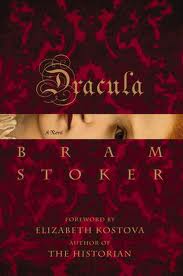Dracula by Bram Stoker
Reviewed by Ellen

Ratings Explanation
Language: Several profanities; “hell” and “hellish”; foul name-calling.
Violence: A woman’s child is taken from her; the woman is devoured by a pack of wolves. A patient in an insane asylum throws violent fits and eats spiders and sparrows alive. All the sailors on a Russian ship disappear one by one and are found dead; one is found with his neck broken. The ship’s captain is also found dead, tied to the helm with a crucifix in his hand. The asylum patient, Renfield, slashes a doctor’s wrist and licks up the blood that drips on the floor. He escapes the asylum, attacks a cart man in the street, and pounds his head against the pavement until another man intervenes and whips Renfield. Arthur drives a wooden stake through Lucy’s heart, then Van Helsing cuts off her head and fills her mouth with garlic. Renfield is found dead with a fractured skull, a broken back, and his face in a pool of blood. Dracula slashes his chest and forces Mina’s mouth to the wound. Van Helsing kills three vampire women by driving wooden stakes through their chests; their bodies convulse and blood foams at their mouths. They kill the Count by slashing his throat and stabbing him in the heart. Gypsies stab and kill a man.
Sexual Content: Jonathan is seduced by three female vampires; he is uneasy and yet tempted, and feels “a wicked, burning desire that they would kiss me with those red lips.” Arthur and Lucy share a kiss. The three vampiresses’ voluptuousness and beauty is discussed by the men, both “thrilling and repulsive” at the same time; they are animal-like in instinct and lack of inhibition. When Dracula slashes his chest and forces Mina against her will to drink his blood, the scene is clearly more violent than sexual, however the scene has very provocative undertones (due to its forceful imagery, I’ve listed it under violence as well).
Adult Themes: The characters all drink wine, rum, and brandy, sometimes for “medicinal” purposes. Cigar smoking. Morphine is prescribed both for pain and stress; Mina takes it to coax her to sleep. When Lucy becomes one of the “undead”, she lures young children away at night to quench her thirst, causing the townspeople to worry that someone is abducting their children. They all return by morning, mostly unhurt but with the tell-tale throat wounds. Count Dracula holds Jonathan prisoner in his castle for weeks; he escapes but is profoundly scarred both mentally and emotionally.
Synopsis
When young attorney Jonathan Harker is sent from London to Transylvania on business, he begins to suspect something sinister about his client, Count Dracula, a wealthy man buying an estate in England. Before he even arrives at the castle, the villagers whisper and worry for him, making the sign of the holy cross and begging him to reconsider his business. Not one to be superstitious, Jonathan goes anyway, and becomes the Count’s unwitting prisoner. He notices that the Count never eats, and spies him crawling down the exterior walls of the castle at night like an insect. One night he wakes to find himself surrounded by three beautiful yet nefarious women, who attempt to seduce Jonathan and bite his neck but are interrupted by the Count, who seeks to “save” Jonathan for himself. When the Count leaves for London, Jonathan escapes and gets word to his fiancee, Mina, who nurses him back to health from what she thinks is a vicious fever and nervous breakdown. Mina faithfully promises not to question Jonathan about his illness, knowing that doing so will harrow up in his memory the cause of his breakdown.
Meanwhile in London, Mina’s recently engaged friend Lucy has suddenly taken ill. Becoming weaker and paler by the day, her fiance Arthur sends for the esteemed Dr. Abraham Van Helsing, whose initial suspicions upon seeing her inexplicable neck wound are that a vampire has come to London. Realizing his theories will sound unbelievable, Van Helsing keeps them to himself and works to save Lucy through transfusions and superstition (garlic wreaths and crucifixes). Eventually, however, Lucy succumbs and dies. Children mysteriously begin disappearing at night and reappearing the morning after with strange wounds on their necks but little memory of their abductions other than a beautiful lady was there. Days later when Van Helsing takes his colleague Dr. Seward to the crypt where Lucy’s coffin lays, her body is gone and their suspicions are confirmed: Lucy has joined the “undead”. What follows is the engrossing hunt for Count Dracula, a harrowing journey embarked upon by Van Helsing and his comrades, all of whom must stay one step ahead of the vampire to avoid succumbing to his possession.
Written in 1896, the original vampire tale still captivates readers with its lavish descriptions of the Romanian countryside and haunting language. It is not for the squeamish (if you are, I suggest reading it in broad daylight), and the violence will likely disturb younger readers (-14 yrs), although the 19th century writing seems far less gory by today’s standards. Still, I recommend this worthwhile tale. High school and up.










